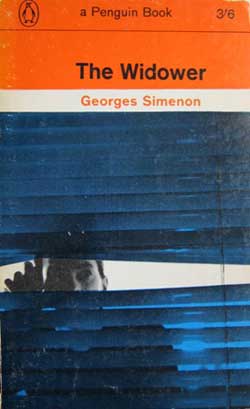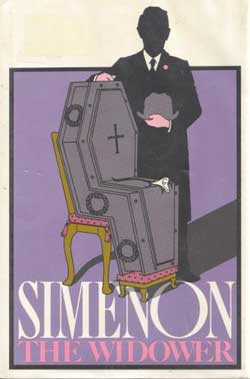 I don’t know if we can say with certainty that Georges Simenon was the most successful writer of the 20th Century, but he would certainly be a top contender for the title. It wasn’t just that he wrote books that sold well around the world, it was that he churned out a new book seemingly every week. A ballpark estimate of his output is somewhere in the neighborhood of five hundred books, and that’s in addition to reams of articles and short stories. His most famous creation was Chief Inspector Jules Maigret, who headlined 75 different novels, 28 short stories, and dozens of movies and television shows. IMBD puts the total number of Simenon adaptations at 137. Anyway you cut it, those are some impressive numbers.
I don’t know if we can say with certainty that Georges Simenon was the most successful writer of the 20th Century, but he would certainly be a top contender for the title. It wasn’t just that he wrote books that sold well around the world, it was that he churned out a new book seemingly every week. A ballpark estimate of his output is somewhere in the neighborhood of five hundred books, and that’s in addition to reams of articles and short stories. His most famous creation was Chief Inspector Jules Maigret, who headlined 75 different novels, 28 short stories, and dozens of movies and television shows. IMBD puts the total number of Simenon adaptations at 137. Anyway you cut it, those are some impressive numbers.
But they are, in the end, just numbers. The real success for a writer, of course, is found in the work itself, and Simenon’s literary reputation was just about on par with his output. The Maigret novels remain masterful models a certain kind of psychologically loaded pop mystery. Simenon could concoct a puzzle as well as anyone, but it’s not really the puzzle that you care about. A Maigret mystery is as likely to be a whydunit as a whodunit. Oftentimes, you’ll see Maigret compared to other famous sleuths—Sherlock Holmes, Hercule Poirot—but he’s a quiet companion to that kind of company. He’s neither an arrogant robot like Holmes nor a preening dandy like Poirot. He is, instead, a sturdy professional. Moreover, outside of his detecting skills, his most marked characteristic is, of all things, compassion. The success of the character owes a lot to the fact that he is, in the end, simply a good man.
As successful as the Maigret series was, however, Simenon’s outsized reputation as a writer actually hinged more on what he called the “non-Maigrets,” the 400-odd romans durs, or “hard novels,” that he published over the course of his career. Short, intense, and often deeply sad, many of these novels are small gems from a writer who never seemed to tire of digging for the truth.
 Take, for instance, a compact little masterpiece like 1959’s The Widower (or Le Veuf). It tells the story of a freelancing designer named Bernard Jeantet who returns to his home in Paris from work one day to discover that his wife, Jeanne, is missing. Years ago, they met under extraordinary circumstances—Jeanne was a prostitute and Bernard took her in after she was viciously attacked by her pimp on the street—but they’ve lived a quiet life since then. A life that, at least in Bernard’s mind, was one of contentment and happiness until she goes missing. When Bernard learns what has become of his wife—and the title of the book only hints at what has happened—his entire life is turned upside down.
Take, for instance, a compact little masterpiece like 1959’s The Widower (or Le Veuf). It tells the story of a freelancing designer named Bernard Jeantet who returns to his home in Paris from work one day to discover that his wife, Jeanne, is missing. Years ago, they met under extraordinary circumstances—Jeanne was a prostitute and Bernard took her in after she was viciously attacked by her pimp on the street—but they’ve lived a quiet life since then. A life that, at least in Bernard’s mind, was one of contentment and happiness until she goes missing. When Bernard learns what has become of his wife—and the title of the book only hints at what has happened—his entire life is turned upside down.
Like so many of Simenon’s hard novels, The Widower is a character study. With a jeweler’s eye for flaws, Simenon takes the modest Jeantet and turns him around and around under the glass until all of the unassuming little man’s assumptions are revealed. While this process is exacting and unsentimental, it is never harsh or malicious. Simenon’s great gift was a kind of intense empathy that never sparred his characters the brutal consequences of their actions.
What he reveals in Bernard is the way that a quiet life can mask a rigid set of expectations. At one point, Simenon writes of the little man:
He had taken care to set limits to his domain and to surround it with protective barriers […] and now, all of the sudden, from one hour to the next, almost from one minute to the next, everything had begun to collapse.
Could there be a passage that more clearly sums up the underlying ethos of the noir novel? The Widower has that ethos in abundance, as abundant as anything by Cain or Goodis. Later in the book, Simenon sums up the slow passage of time this way:
He was […] numb, mentally and physically, and there were long periods during which everything became confused, both his thoughts and his feelings.
In this way he got through the night. There was another day. Then another night. In the end, time disappeared, the hours faded away, there was nothing and there was everything, a void peopled with expectation and figures which were now grey, now colored.
Like an astounding amount of Simenon’s fiction, The Widower manages to pull off the neat trick of being a heartbreaking pageturner. It runs all of 143 pages (in its 1961 Penguin Books edition), and not a page of that is wasted. It begins with a mystery, follows that mystery to a shocking revelation, and then begins to recoil into the past in search of answers, in search of some kind of truth. It is brilliant, shocking, and sad. It is, in a word, beautiful.
Jake Hinkson is the author of several books, including the novel The Big Ugly and the newly-released short story collection The Deepening Shade.
Read all of Jake Hinkson's posts for Criminal Element.

PS. There are too many Simenon stand alones to single out for greatest. (Again, my man wrote A LOT of books), but I’d also recommend UNCLE CHARLES HAS LOCKED HIMSELF IN and THE MAN WITH THE LITTLE DOG. Like THE WIDOWER, they begin with intriguing hooks and then unfurl into the past. They’re sad and beautiful–fascinating books.